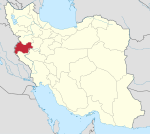| Takyeh Moaven-ol-olk
تکیه معاونالملک | |
|---|---|
 | |
| Location | Kermanshah, Iran |
| Coordinates | 34°18′49″N 47°04′13″E / 34.313551°N 47.070376°E / 34.313551; 47.070376 |
| Built | 1903 |
| Architect | Hossein naghash e tehrani Seyed abulqsem mani Hossein khan Moein al-roaya |
| Architectural style(s) | Persian architecture |
 | |
Takyeh Moaven-ol-Molk (Persian:تکیه معاون الملک) is a takyeh and historical place located in Kermanshah city of Iran. It was built during Qajar era as a Shia mourning site. On 1 December 1975 Tekyeh Moaven al-molk was recognized as National monument of Iran. It is well known for its exclusive tiling, picturing Islamic era Ghazi (warrior), Battle of Karbala and Iranian kings such as Achaemenid kings and Persepolis. It has three main parts: Hussainiya, Zaeynabiya and Abbasiya. Museum of Anthropology of Kermanshah, and Clothes and Jewelry Museum of Kermanshah are located in Abbasiya.
Gallery
-
-
Lion and Sun
-
-
-
Abbasiya
-
 according to Indigenous Peoples believes this heritage Sanctificated by 8th Shia Imam
according to Indigenous Peoples believes this heritage Sanctificated by 8th Shia Imam
-
 ancient history of Iran
ancient history of Iran
-

-
story of Joseph
-
 story of Soleiman ibn sor'al-khaza'i
story of Soleiman ibn sor'al-khaza'i
-
 dome
dome
References
- "Tekyeh Moaven al-molk of Kermanshah". Association of Iranian architecture fames (in Persian).
| Kermanshah province, Iran | ||
|---|---|---|
| Capital |  | |
| Counties and cities | ||
| Sights |
| |
| populated places | ||


